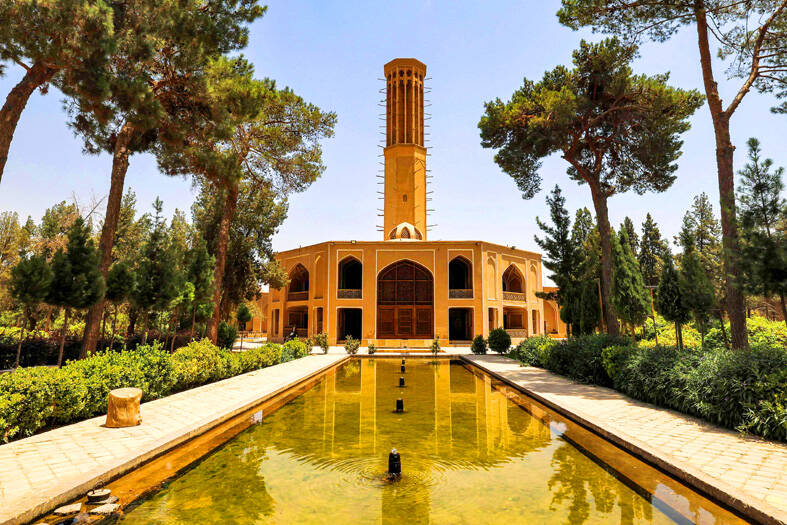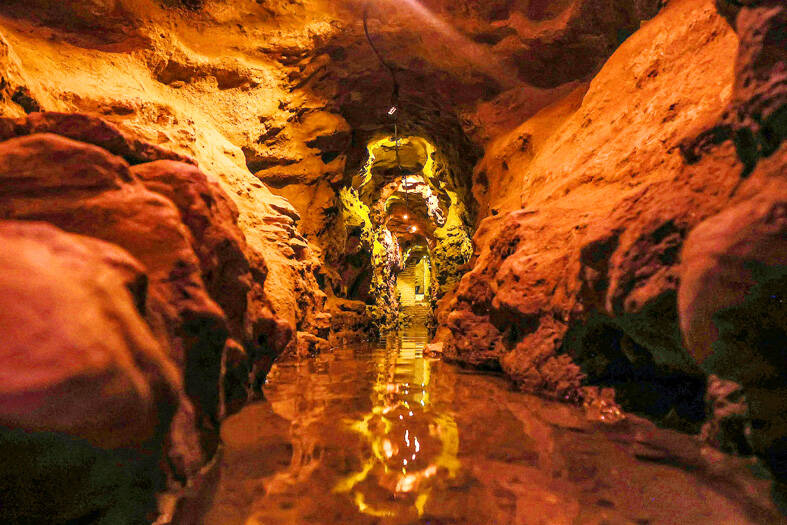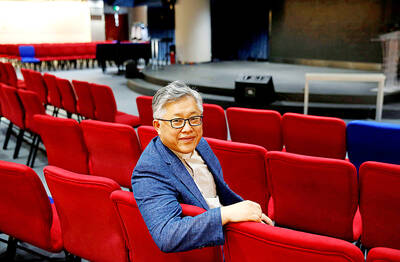Tall, chimney-like towers rise from centuries-old adobe houses in Iran’s desert city of Yazd, drawing in a pleasant breeze for residents of one of the hottest cities on earth. The windcatchers, called badgir in Persian, are just one of the engineering marvels inhabitants have developed in this ancient city where temperatures reach well above 40°C in the summer. And, unlike energy-guzzling air conditioners, they are cost and carbon-free.
“For centuries, before we had electricity, they made it possible to cool dwellings,” said Abdolmajid Shakeri, the provincial deputy of Iran’s Ministry of Cultural Heritage, Handicrafts and Tourism.
The oldest of the city’s 700 windcatcher dates back to the 14th century, but the architectural feature is believed to date back as far as 2,500 years when the Persian Empire ruled over much of the Middle East.

Photo: AFP
“The badgirs played a key role in the city’s prosperity,” Shakeri said about the desert city that was a caravan stop on the ancient Silk Road.
“Thanks to them, people lived at ease,” he added, describing how the windcatchers pull fresh air into buildings and allow hot air to ventilate out through large vertical slots.
Majid Oloumi, the head of Dowlat Abad Garden, home to a towering 33.8m windcatcher — one of the tallest in the world — described the cooling method as “totally clean, because it uses neither electricity nor polluting materials.”

Photo: AFP
UNESCO listed Yazd as a World Heritage Site in 2017, describing the city as a “living testimony to intelligent use of limited available resources in the desert for survival.”
The bioclimatic architecture that provides thermal comfort for the people of Yazd has attracted interest elsewhere on a heating planet.
“Badgirs demonstrate that simplicity can be an essential attribute to sustainability,” said Paris-based architect Roland Dehghan Kamaraji, who has studied Iran’s windcatcher. “It goes against the common misconception that sustainable solutions need to be complex or high-tech.”
At a sustainable urban community called Masdar city in the United Arab Emirates, buildings have been “designed to make use of the natural ventilation for cooling, like badgirs,” he said.
Similarly, ventilation inspired by “termite mounds, an approach similar to that of badgirs,” was built atop Eastgate Center, a shopping mall and office complex in Harare, Zimbabwe.
However, Yazd’s unique architectural traditions have largely been abandoned at their birthplace.
“Unfortunately, our ancestral heritage has been forgotten,” especially since the emergence of air conditioners, Oloumi said.
Yazd’s old town is a labyrinth of narrow streets and roofed alleyways. Its centuries-old edifices made of clay, mud-brick and adobe all provide insulation against the torrid heat. However, the old houses stand in sharp contrast to modern cement buildings and multi-lane roads.
“Today, house architecture imitates that in other countries, and cement-based construction does not correspond to the climate of Yazd,” he added.
Kamaraji said bioclimatic architecture has waned due to economic constraints and modern construction methods that “largely favor the use of energy and fossil fuel intensive materials.”
Another sustainable architectural feature of Yazd is its system of underground aqueducts called qanats, which transport water from underground wells, aquifers or the mountains.
“These underground aqueducts have great utility,” said Zohreh Montazer, an expert on the water system. “They constitute a source of water supply and make it possible to cool the dwellings and to preserve food at an ideal temperature.”
Iran is estimated to have about 33,000 operational qanats today, a significant drop from the 50,000 in use in the mid-20th century.
UNESCO says the decline in qanats is driven in part by the drying up of underground water sources due to overconsumption.
Iranian authorities have in recent years sought to rehabilitate the qanat of Zarch — considered the longest and oldest, dating about 3,000 years ago.
The water network — which stretches more than 70km across Yazd and runs at a depth of about 30m — stands as a reminder for Yazd’s residents of the challenges ahead.
“The day when fossil fuels run out, we will have to return to these methods,” Montazer said.

STEPPING UP: Diminished US polar science presence mean opportunities for the UK and other countries, although China or Russia might also fill that gap, a researcher said The UK’s flagship polar research vessel is to head to Antarctica next week to help advance dozens of climate change-linked science projects, as Western nations spearhead studies there while the US withdraws. The RRS Sir David Attenborough, a state-of-the-art ship named after the renowned British naturalist, would aid research on everything from “hunting underwater tsunamis” to tracking glacier melt and whale populations. Operated by the British Antarctic Survey (BAS), the country’s polar research institute, the 15,000-tonne icebreaker — boasting a helipad, and various laboratories and gadgetry — is pivotal to the UK’s efforts to assess climate change’s impact there. “The saying goes

FRUSTRATIONS: One in seven youths in China and Indonesia are unemployed, and many in the region are stuck in low-productivity jobs, the World Bank said Young people across Asia are struggling to find good jobs, with many stuck in low-productivity work that the World Bank said could strain social stability as frustrations fuel a global wave of youth-led protests. The bank highlighted a persistent gap between younger and more experienced workers across several Asian economies in a regional economic update released yesterday, noting that one in seven young people in China and Indonesia are unemployed. The share of people now vulnerable to falling into poverty is now larger than the middle class in most countries, it said. “The employment rate is generally high, but the young struggle to

ENERGY SHIFT: A report by Ember suggests it is possible for the world to wean off polluting sources of power, such as coal and gas, even as demand for electricity surges Worldwide solar and wind power generation has outpaced electricity demand this year, and for the first time on record, renewable energies combined generated more power than coal, a new analysis said. Global solar generation grew by a record 31 percent in the first half of the year, while wind generation grew 7.7 percent, according to the report by the energy think tank Ember, which was released after midnight yesterday. Solar and wind generation combined grew by more than 400 terawatt hours, which was more than the increase in overall global demand during the same period, it said. The findings suggest it is

Police in China detained dozens of pastors of one of its largest underground churches over the weekend, a church spokesperson and relatives said, in the biggest crackdown on Christians since 2018. The detentions, which come amid renewed China-US tensions after Beijing dramatically expanded rare earth export controls last week, drew condemnation from US Secretary of State Marco Rubio, who on Sunday called for the immediate release of the pastors. Pastor Jin Mingri (金明日), founder of Zion Church, an unofficial “house church” not sanctioned by the Chinese government, was detained at his home in the southern city of Beihai on Friday evening, said